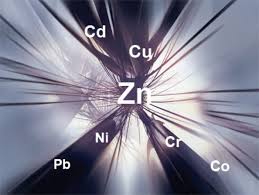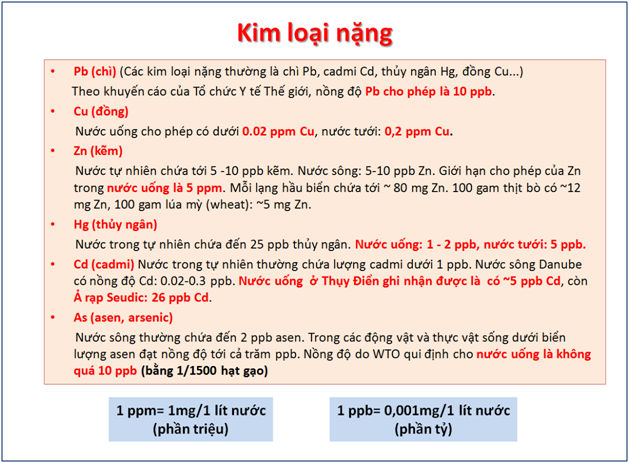Heavy metals - Toxicity and pollution status (P1)
.................................................. ........................
1. What is heavy metal?
Heavy metals are those that have a density greater than 5g / cm3.
Some heavy metals may be necessary for organisms, they are considered microelements. Heavy metals are toxic to the environment and the organism when their content exceeds the permitted standard.

2. Some heavy metals have high toxicity
Lead (Pb)
Lead (Pb): is an element with high toxicity to human health. Lead is toxic to the central nervous system, peripheral nervous system, acts on the enzyme system with a hydrogen-containing activity group. People with lead poisoning will have disorders of the haematopoiesis (bone marrow). Depending on the degree of toxicity, abdominal pain, arthralgia, nephritis, high blood pressure, brain complications, severe poisoning can be fatal. The outstanding feature is that after getting into the body, lead is less eliminated and accumulates over time before causing toxicity.
- Lead enters the human body through contaminated drinking water, air and food.
- Lead accumulates in bones, inhibiting calcium metabolism by inhibiting vitamin D metabolism.
- The maximum permitted standard according to WHO lead concentration in drinking water: £ 0.05 mg / ml.
Mercury (Hg)
Mercury (Hg): toxicity depends on its chemical form. Elemental mercury is relatively inert, non-toxic. If swallowed metal mercury will then be discharged without serious consequences. But mercury is volatile at room temperature so if inhaled it would be very toxic. Mercury is capable of reacting with sulfur amino acids, hemoglobin, abumin; capable of binding cell membranes, altering potassium content, changing the base acid balance of tissues, causing a lack of energy supply to nerve cells. Children with mercury poisoning will be schizophrenic, not active seizures. In water, methyl mercury is the most toxic form, it causes chromosomal schizonts and prevents cell division.
- Mercury introduced into the environment from waste products, smoke and dust of metallurgical plants, producing fluorescent lamps, thermometers, pesticides, pulp ...
- The maximum permitted concentration of WHO in drinking water is 1mg / l; Aquaculture water is 0.5mg / l.
Arsenic (As)
Arsenic (As): is a metal that can exist in the form of synthetic inorganic and organic substances. In nature exists in minerals. Low concentration stimulates growth, high concentration is toxic to plants and animals.
- Natural sources of arsenic pollution are volcanoes, ocean dust. Artificial sources of arsenic pollution are copper, lead, zinc melting, steel smelting, forest burning, pesticide use ...
- Arsenic can cause 19 different diseases. The main effects on human health: coagulating proteins by forming complexes with arsenic III and destroying phosphorus; causes cancer of skin, lung, bronchus, sinuses ...
- The standard allows according to WHO the arsenic concentration in drinking water is 50mg / l.
Cadmium (Cd)
Cadmium (Cd): is a metal used in the metallurgy and plastics industry; Cadmium compound is used to produce batteries.
Natural sources cause cadmium pollution due to volcanic dust, cosmic dust, forest fire ... Artificial sources are from the metallurgy, plating, paint, plastic industries ...
- Cadmium penetrates into the human body through respiratory and food routes. According to many studies, smokers are at risk of being exposed to cadmium.
- Cadmium enters the body and accumulates in the kidneys and bones; causing interference with some enzymes, causing hypertension, lung cancer, nasal septal perforation, kidney dysfunction, bone marrow destruction, affecting endocrine, blood, and cardiovascular.
- WHO standard for drinking water £ 0.003 mg / l.
Chromium (Cr)
Chromium (Cr): exists in water with two forms Cr (III), Cr (VI). Cr (III) is non-toxic but Cr (VI) is toxic to plants and animals. For people Cr (VI) causes stomach ulcers, small intestine, hepatitis, nephritis, lung cancer.
- Chromium infiltrates water from waste water sources of electroplating, dyeing, tanning, explosives, printing ink, photo printing ...
- WHO standard stipulates chromium content in drinking water is £ 0.005 mg / l.
Manganese (Mn)
Manganese (Mn): is a trace element, needs about 30 - 50 mg / kg body weight per day. If large amounts are toxic to the body; To cause toxicity to the cellular protozoa, especially to the central nervous system, causing kidney damage, circulatory and pulmonary apparatus, and severe poisoning.
- Manganese enters the water environment due to the leaching process, erosion, due to industrial waste from metallurgy, battery, chemical fertilizer.
- WHO regulatory standard in drinking water is £ 0.1 mg / l.


- (05.04.2018)
- (05.04.2018)
- (27.03.2018)
- (26.03.2018)
- (12.03.2018)
- (12.03.2018)
- ENVIRONMENTAL REGULATION (16.10.2017)
- ACE VIETNAM FACTORY (14.10.2017)
- ANNUAL TEAM BUILDING ACTIVITY (19.10.2017)






























-4751.jpg)
-4136.png)
-6592.jpg)

-7524.png)

-9794.png)
-9847.png)


